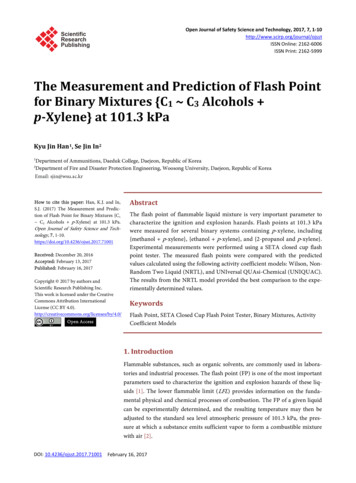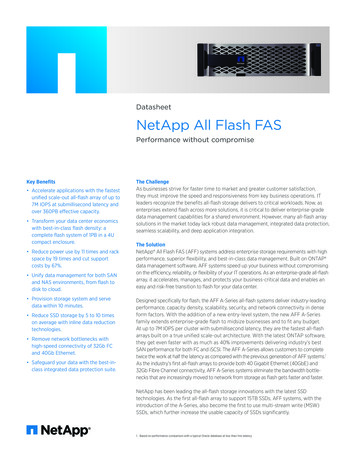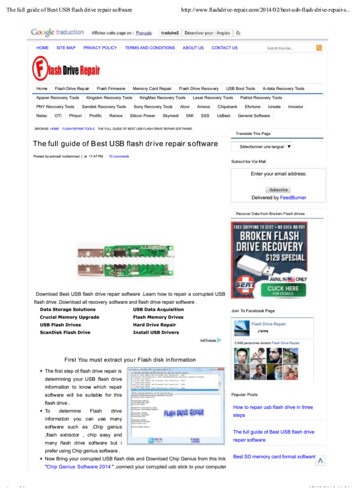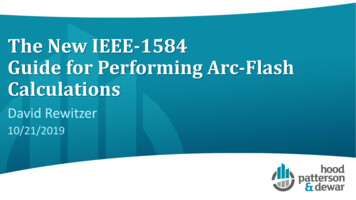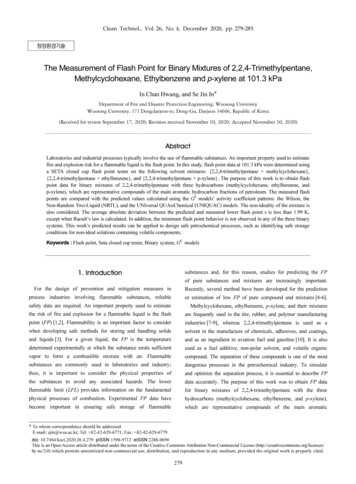
Transcription
Clean Technol., Vol. 26, No. 4, December 2020, pp. 279-285청정환경기술The Measurement of Flash Point for Binary Mixtures of 2,2,4-Trimethylpentane,Methylcyclohexane, Ethylbenzene and p-xylene at 101.3 kPaIn Chan Hwang, and Se Jin In*Department of Fire and Disaster Protection Engineering, Woosong UniversityWoosong University, 171 Dongdaejeon-ro, Dong-Gu, Daejeon 34606, Republic of Korea(Received for review September 17, 2020; Revision received November 10, 2020; Accepted November 10, 2020)AbstractLaboratories and industrial processes typically involve the use of flammable substances. An important property used to estimatefire and explosion risk for a flammable liquid is the flash point. In this study, flash point data at 101.3 kPa were determined usinga SETA closed cup flash point tester on the following solvent mixtures: {2,2,4-trimethylpentane methylcyclohexane},{2,2,4-trimethylpentane ethylbenzene}, and {2,2,4-trimethylpentane p-xylene}. The purpose of this work is to obtain flashpoint data for binary mixtures of 2,2,4-trimethylpentane with three hydrocarbons (methylcyclohexane, ethylbenzene, andp-xylene), which are representative compounds of the main aromatic hydrocarbon fractions of petroleum. The measured flashpoints are compared with the predicted values calculated using the GE models’ activity coefficient patterns: the Wilson, theNon-Random Two-Liquid (NRTL), and the UNIversal QUAsiChemical (UNIQUAC) models. The non-ideality of the mixture isalso considered. The average absolute deviation between the predicted and measured lower flash point s is less than 1.99 K,except when Raoult’s law is calculated. In addition, the minimum flash point behavior is not observed in any of the three binarysystems. This work’s predicted results can be applied to design safe petrochemical processes, such as identifying safe storageconditions for non-ideal solutions containing volatile components.Keywords : Flash point, Seta closed cup tester, Binary system, GE modelssubstances and, for this reason, studies for predicting the FP1. Introductionof pure substances and mixtures are increasingly important.For the design of prevention and mitigation measures inRecently, several method have been developed for the predictionprocess industries involving flammable substances, reliableor estimation of low FP of pure compound and mixtures [4-6].safety data are required. An important property used to estimateMethylcyclohexane, ethylbenzene, p-xylene, and their mixturesthe risk of fire and explosion for a flammable liquid is the flashare frequently used in the tire, rubber, and polymer manufacturingpoint (FP) [1,2]. Flammability is an important factor to considerindustries [7-9], whereas 2,2,4-trimethylpentane is used as awhen developing safe methods for storing and handling solidssolvent in the manufacture of chemicals, adhesives, and coatings,and liquids [3]. For a given liquid, the FP is the temperatureand as an ingredient in aviation fuel and gasoline [10]. It is alsodetermined experimentally at which the substance emits sufficientused as a fuel additive, non-polar solvent, and volatile organicvapor to form a combustible mixture with air. Flammablecompound. The separation of these compounds is one of the mostsubstances are commonly used in laboratories and industry;dangerous processes in the petrochemical industry. To simulatethus, it is important to consider the physical properties ofand optimize the separation process, it is essential to describe FPthe substances to avoid any associated hazards. The lowerdata accurately. The purpose of this work was to obtain FP dataflammable limit (LFL) provides information on the fundamentalfor binary mixtures of 2,2,4-trimethylpentane with the threephysical processes of combustion. Experimental FP data havehydrocarbons (methylcyclohexane, ethylbenzene, and p-xylene),become important in ensuring safe storage of flammablewhich are representative compounds of the main aromatic* To whom correspondence should be addressed.E-mail: sjin@wsu.ac.kr; Tel: 82-42-629-6771; Fax: 82-42-629-6779doi: 10.7464/ksct.2020.26.4.279 pISSN 1598-9712 eISSN 2288-0690This is an Open-Access article distributed under the terms of the Creative Commons Attribution Non-Commercial License (http://creativecommons.org/licences/by-nc/3.0) which permits unrestricted non-commercial use, distribution, and reproduction in any medium, provided the original work is properly cited.279
280 In Chan HwangㆍSe Jin InTable 1. The purities, FPs and UNIQUAC parameters of chemicals used in this work.G.C. analysis(wt %)Chemicals2,2,4-trimethylpentanea 99.8Flash Point (K)at 101.3 kPaUNIQUACThis 9240Methylcyclohexane 99.8268.45269.154.72003.7760Ethylbenzene 99.7295.35294.154.59723.5080p-xylene 99.9299.45300.154.65783.5360bRef. [14], Ref. [15]hydrocarbon fractions of petroleum.to 573.15 K. The temperature of the liquid sample in the sampleIn the present work, the FPs at 101.3 kPa were determinedcup was regulated using the temperature controller, which hadusing a SETA closed cup flash point tester on the followingan accuracy of 0.1 K. The SETA closed-cup flash point testersolvent mixtures: {2,2,4-trimethylpentane (1) methylcyclohexanewas calibrated periodically using a standard tester solvent.(2)}, {2,2,4-trimethylpentane (1) ethylbenzene (2)} and {2,2,4-Approximately 2 mL of the sample mixture was weighed usingtrimethylpentane (1) p-xylene (2)}. The experimental FP dataa microbalance (Ohaus DV215CD) of precision 1 10-5 g. Thefor these binary systems were compared with predicted valuesheavier component of the binary mixtures was weighed first tofrom a variety of activity coefficient models: Wilson, Non-Randomminimize vaporization. The systematic error associated with theTwo-Liquid (NRTL) and UNIversal QUAsiChemical (UNIQUAC)experiments was estimated to be less than 1 10-4 in terms ofmodels [11-13].molefraction. A time interval of 15 min was imposed betweenmeasurements to attain a constant temperature and stabilize2. Material and Methodsoscillations. The experimental procedure is described in detailelsewhere [17-19].2.1. MaterialsCommercial grade 2,2,4-trimethylpentane (C8H18,M 114.23g mol-1, CAS-RN 540-84-1, 99.8%) and methylcyclohexane3. Results and Discussion(C7H14,M 98.19 g mol-1, CAS-RN 108-87-2, 99.8%) wereAt the FP of a liquid solution, the Le Chatelier’s principle [20],supplied from Aldrich Chemical Co. Ethylbenzene (C8H10,M which describes the lower flammable limit of a gas mixture, is106.17 g mol-1, CAS-RN 100-41-4, 99.5%) and p-xyleneexpressed as follows:-1(C8H10,M 106.17 g mol , CAS-RN 106-42-3, 99.9%) weresupplied from Fluka Co. All components were dried usingmolecular sieves of pore diameter 0.4 nm. The water content ofthe chemicals, determined using a Karl-Fischer titrator (Metrohm684 KF-Coulometer), was less than 6 10-5 g g-1. The purity ofthe chemicals was assessed through gas chromatography. Thepurities, FPs, and UNIQUAC parameters of the chemicals arelisted in Table 1 along with the reported values [14,15].2.2. ProcedureSETA closed-cup flash point tester (Series 8 SETAFLASH,model 82000-0, Surrey, UK) was used to measure the FPs ofthe three miscible mixtures. The SETA closed-cup flash pointtester was operated according to the standard test method,ASTM D 3278 [16]. The abovementioned tester comprises fourcomponents: a sample cup, a test flame device with a flamecontroller, a temperature-measuring system with a temperaturecontroller, and a time controller. The injection volume was 2mL, and the measured temperature range was set from 253.15.1 iyiLFLi(1)where yi is the vapor phase composition of a flammablesubstance i and LFLi is the lower flammable limit of the purecomponent i. LFLi is expressed in terms of the vapor pressuresatof i at its FP, i.e., Pi ,FP , as follows:LFLi Pi ,satFPP(2)where P represents the ambient pressure. The FP of a puresubstance is typically measured at the standard atmosphericpressure. Under this condition, the vapor phase behaves ideally.In a liquid mixture containing flammable substances in thepresence of non-condensable components of air, the vapor-liquidequilibrium of component i is described by the following equation:yi P xi i Pi sat(3)
The Measurement of Flash Point for Binary Mixtures of 2,2,4-Trimethylpentane, Methylcyclohexane, Ethylbenzene and p-xylene at 101.3 kPa281Table 2. The Antoine coefficients of the componentsAntoine coefficients 3215.300Ref. [15]In Equation (3), γi, xi, and yi are the liquid phase activityWilson equation:coefficient, liquid molar fraction, and vapor molar fraction,respectively.(2) and (3) into Equation (1), resulting in Equation (4), whichallows the evaluation of FPs for flammable liquid mixtures. isatxi i PiPi ,satFP(4)ln ifollows [22]:jijAccording to being proposed by Liaw et al. [21], the ij exp( jijjj ij iiRTijkj kkg ij g ii) k xk kjGkj ij k Gkj xk UNIQUAC equation:ln i ln iC ln iRx p sat x p sat x p sat i ipisat i 1p1sat 1 2p sat2 2 1i , FP1, FP2, FPln iC 1 J i ln J i 5qi (1 (6)j, presented in Equation (6), can be calculated byAssuming that the solution is ideal, the activity coefficients ofthe liquid phase are equal to unity. Therefore, Equation (4)was reduced according to Raoult’s law and is expressed asJi ri rj x j ixi PixP Pi ,satPFP sat2 2sat2 , FPxPP 1(7)Li j ijSj)qi qjxjSi l liljxi qi x qjsat1 1sat1, FPJiJ ln i )LiLiwith i follows [23]:sat(10)ln iR qi (1 ln Si jsubstituting the FP of the pure component i into Equation (5).(9)Gij exp ij ij RTresults in:PVi 2ki kliterature and are listed in Table 2.substitution Equation (2) and Equation (3) into Equation (1)(8)kjwithThe Antoine coefficients A, B, and C were adapted from thesati , FPV j2 G xxG Gx G xk(5)jNRTL equation:The saturated vapor pressure variation with temperature for aBC T / C x withpure substance i can be obtained using the Antoine equation aslog P sat (mmHg ) A nj 1 ij 1k 1j 1As proposed by Liaw et al. [21], one can substitute Equationsx j jinnln i ln( x j ij ) 1 jj ij exp (uij uii )RTThe FP data for {2,2,4-trimethylpentane (1) methylcyclohexane(2)}, {2,2,4-trimethylpentane (1) ethylbenzene (2)}, andThe temperature that satisfies Equation (7) is determined to{2,2,4-trimethylpentane (1) p-xylene (2)} mixtures werebe the FP of the binary mixture. For non-ideal liquid mixtures,determined over the entire composition range. The optimized binarythe activity coefficients (gi) were estimated using the optimumparameters for the Wilson, NRTL and UNIQUAC model used tobinary interaction parameters of the Wilson, NRTL, andestimate the activity coefficients were taken from literature referencesUNIQUAC equations, described below [11-13].and are provided in Table 3 [24-25].
282 In Chan HwangㆍSe Jin InTable 3. The optimized binary parameters of the Wilson, NRTL and UNIQUAC equations for each binary systemWilsonSystemsaNRTLUNIQUACA12/J mol-1A21/J mol-1A12/J mol-1A21/J mol-1αA12/J mol-1A21/J mol-1{2,2,4-trimethylpentane (1) methylcyclohexane (2)} methylpentane (1) ethylbenzene (2)} 2,4-trimethylpentane (1) p-xylene (2)} b181.016803.464-72.8341056.3220.4105.98163.143Ref. [24], b Ref. [25]The optimized binary parameter is provided for the systemThe experimental data from the analysis of each binary{2,2,4-trimethylpentane (1) methylcyclohexane (2)} from VLEsystem at 101.3 kPa are plotted in Figures 1 to 4. As showndata of the literature [24]. And the NRTL and UNIQUACfrom the minimum values of A.A.D, in all cases, theparameters are provided for the systems {2,2,4-trimethylpentaneexperimental data agree well with the predicted values. In(1) ethylbenzene (2)} and {2,2,4-trimethylpentane (1) addition, minimum flash point behavior (MFPB) was notp-xylene (2)} in Ref. [25], thus the parameters of Wilson modelobserved in any of the three binary systems. The proposedwere also made in this work.approach for predicting the FP of aromatic hydrocarbon blendsThe experimental binary FP data for the systems {2,2,4-with 2,2,4-timethylpentane proved to be accurate, having lowtrimethylpentane (1) methylcyclohexane (2)}, {2,2,4-deviations over almost the entire range of mixture compositions.trimethylpentane (1) ethylbenzene (2)} and {2,2,4-trimethylpentaneFor the investigated systems, the A.A.D values between the(1) p-xylene (2)} are presented in Table 4. The resulting binarypredicted and measured FP values were less than 1.99 K, exceptdata were compared with the predicted values from the activitywhen calculated by Raoult’s law. The Wilson model yieldedcoefficient models of Wilson, NRTL and UNIQUAC models.results closest to those of the experimentally determined binaryThe resulting binary data were compared with the predictedsystems {2,2,4-trimethylpentane (1) methylcyclohexane (2)}values from the activity coefficient models of the Wilson,and {2,2,4-trimethylpentane (1) p-xylene (2)}. The minimumNRTL, and UNIQUAC models. The binary parameters of eachmodel equation were used to calculate the activity coefficientsunder the same conditions used in the experiments, and etemperature of each mixture. Subsequently, the FP was obtainedby adjusting the initial temperature by satisfying Le Chatelier’srule (Equation 4). The objective function (OF) used is expressedas follows: x i Pi sat OF min i sat ) 1 i Pi ,FP (10)For Raoult’s law, the activity coefficient was equal to unitybased on the assumption of an ideal liquid phase. The averageabsolute deviations (A.A.D) between the experimental andcalculated values ar
Keywords : Flash point, Seta closed cup tester, Binary system, GE models . 280 In Chan Hwang ㆍSe Jin In hydrocarbon fractions of petroleum. In the present work, the FPs at 101.3 kPa were determined using a SETA closed cup flash point tester on the following solvent mixtures: {2,2,4-trimethylpentane (1) methylcyclohexane (2)}, {2,2,4-trimethylpentane (1) ethylbenzene (2)} and {2,2,4 .
